
Reviews are a fundamental part of buying on Amazon. They have also been one of the areas that have changed the most over the last decade.
As Amazon continues to ****** as a marketplace, it has become very sensitive to review manipulation. Using outdated tactics can trigger Amazon to remove most, if not all, of your listings.
Even worse, if you are identified as someone manipulating reviews on Amazon, you could be permanently banned from the platform.
Amazon is stringent about reviews because, in the not-too-distant past, reviews were the primary way to manipulate the Amazon search algorithm to have your product show up at the top of search.
While reviews are still important for marketing your products on Amazon, the best practices around reviews have changed significantly in the last few years.
Many of even the legitimate ways used by sellers to gather reviews have disappeared or can now potentially get your listing flagged.
In this article, we will discuss some of the most critical information when creating a product reviews strategy on Amazon in today’s climate.
Over the last several years, Amazon determined that many practices around soliciting reviews were diminishing the reputation of reviews on its platform.
As a result, significant changes around actively monitoring review manipulation are put in place. It includes changing the regulations around how Amazon can reach out to customers to get reviews and what kind of incentives can be offered.
Amazon has tried to balance giving sellers legitimate ways to get their products reviewed while limiting the amount of fraud around reviews.
Having customers trust Amazon reviews is a top priority to protect how reviews are regarded on the platform.
Fundamentals Of Amazon Product Reviews
The importance of reviews derives from the credibility they provide to your product. They help the customer determine if your product is a good fit and can be trusted to be sufficient in quality.
Reviews, in turn, help your listing conversion and even your ad conversion.
Often, the question most sellers struggle with is this: How many reviews do I need for my product to succeed on Amazon?
The answer to that will largely depend on how commoditized or competitive your product category is.
The more competitive your category, the more reviews your product will need to compete against similar products.
For example, if you launch a mobile phone case, you will compete with other items with 10,000 or more reviews. This shows that to have your reviews provide real credibility to your product, you will need a larger number of reviews.
On the other hand, if your product is very niche, you may only need 5 to 15 reviews to be retail-ready. Amazon recommends at least 15 reviews for a listing before you start scaling advertising.
However, for niche products, Amazon has successfully ramped up advertising with strong performance well before that total number of reviews.
Finally, brand awareness will also impact the role of reviews for your product. For example, an official Lego product will sell well despite no reviews.
This is because there is a much-existing affinity for the brand. That same product will sell better, and ads will convert at a higher return on investment (ROI) once it has established reviews.
However, the product doesn’t need reviews to make the customers feel confident in their purchase.
Reviews should be an important part of your listing optimization strategy. This does not only apply to converting traffic that comes to your listing but also to increasing the amount of traffic that comes from the search engine result page (SERP).
Keep in mind that your product rating score will show up in the SERP as well as in your ads. Additionally, customers can filter their results by average reviews.
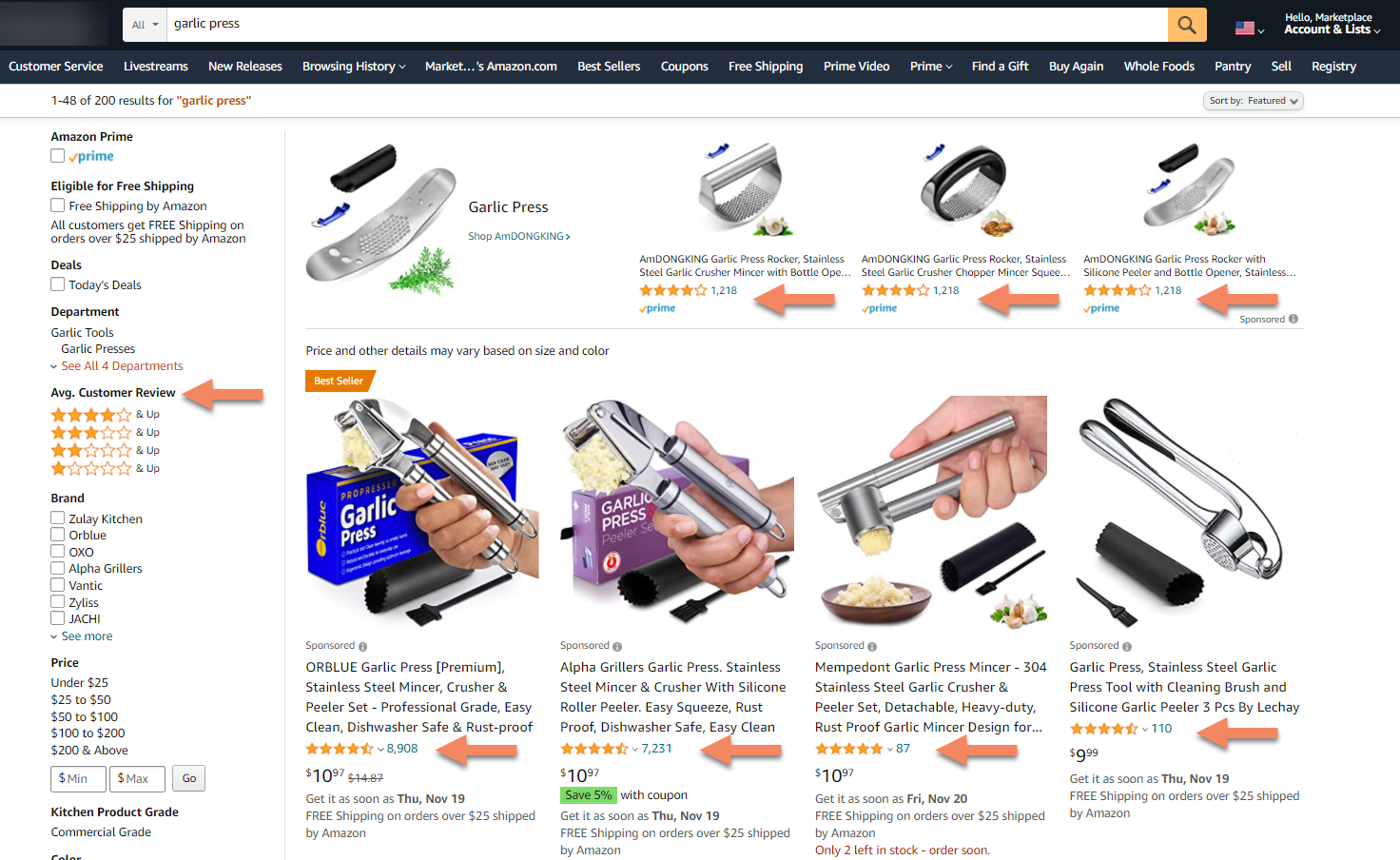
While it is common for brands to be concerned with any negative review, know that an occasional negative review can help show buyers that your reviews are authentic. No product has a 100% adoption rate.
You should be proactively working to reduce the number of negative reviews on your products. Do this by ensuring your product detail page is as clear as possible.
You should also be reviewing Voice of the Customer in Seller Central on a weekly basis to identify any potential negative customer experiences before Amazon might suppress your listings.
Voice of the Customer is an important tool to be able to anticipate issues with quality control or even the content of your listing.
You should look at all negative customer experiences (NCX) to see what you can do proactively to avoid future returns and negative reviews.
Voice of the Customer can be found in Seller Central under the Performance tab.
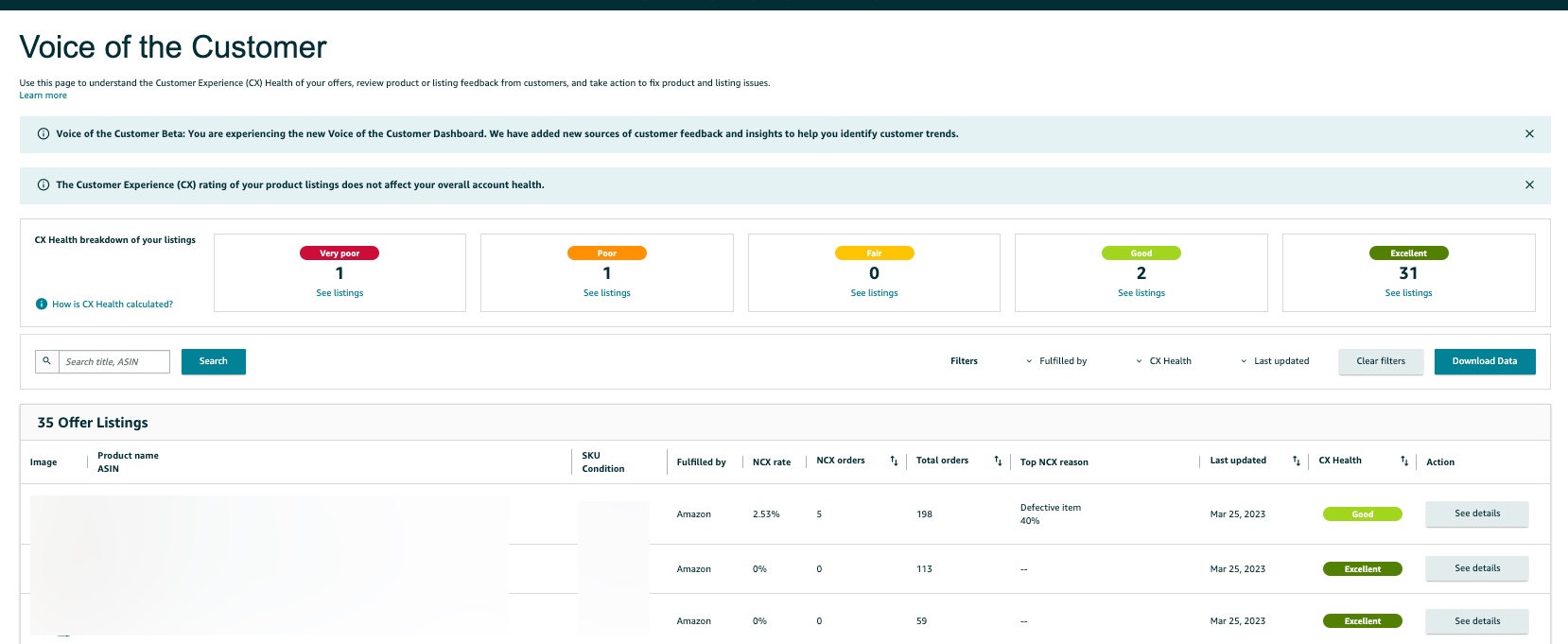 Screenshot from Amazon, March 2023
Screenshot from Amazon, March 2023Use Voice of the Customer as part of your Amazon review strategy to help you limit negative reviews on your products. This can also help you avoid Amazon Standard Identification Number (ASIN) restrictions and reduce your overall return rates.
Feedback Vs. Reviews & Ratings
One common point of confusion for new sellers is the difference between feedback and reviews.
“Seller Feedback” refers to the customer’s experience with the seller, not the product itself.
Seller Feedback
Sellers are rated on different factors, such as shipment times, packaging, product accuracy, and significant customer service experiences.
Seller feedback is found on the Seller Central dashboard, the seller store page, and the product detail page by clicking the offers link.
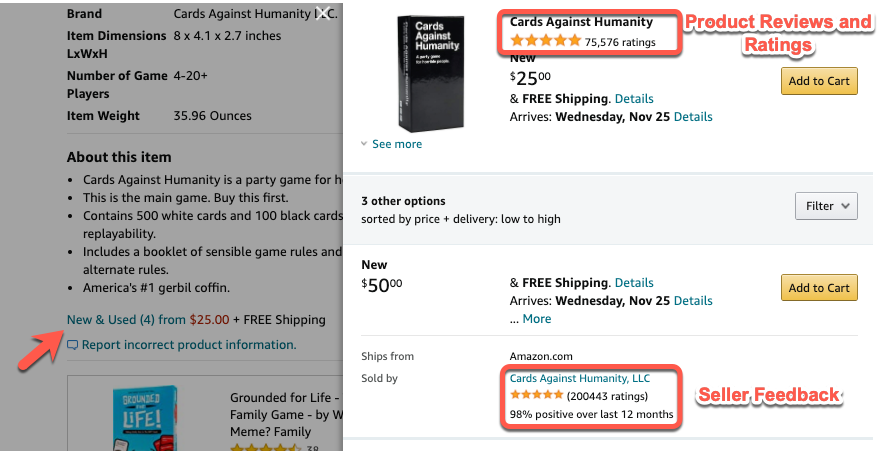 Screenshot from Amazon, March 2023
Screenshot from Amazon, March 2023Product Reviews
Product reviews specifically rate whether the product meets the customer’s expectations.
Product reviews are located at the bottom of the detail page, while the total of both reviews and product ratings are displayed at the top of the listing, below the brand name.
It is important to note that it is against Amazon’s terms of service to have family, friends, or employees review your product or a competitor’s product.
Reviews that violate community standards can be flagged for removal. Amazon will only remove reviews that violate the specific conditions outlined in the community guidelines.
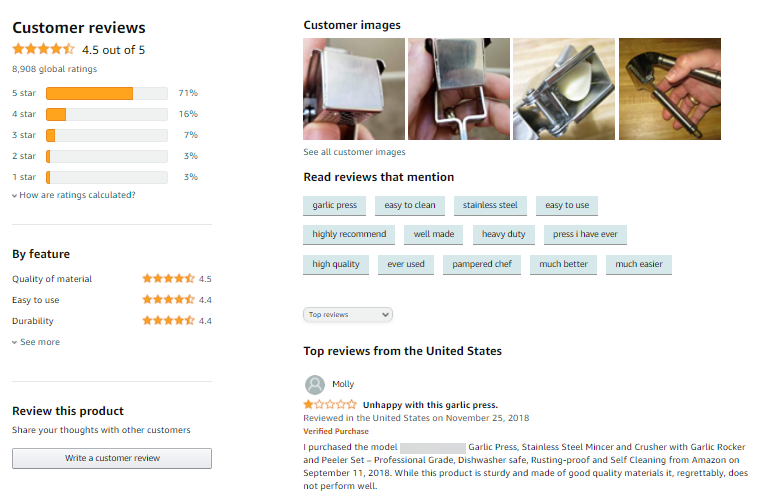 Screenshot from Amazon, March 2023
Screenshot from Amazon, March 2023Recently, Amazon started allowing customers to provide ratings without giving a review.
It has the same star rating as reviews (one to five) and counts toward your overall customer review totals, but it has no accompanying text. This is why some products might have thousands of stars but only a handful of written reviews.
Programs To Help You Get Legitimate Reviews
Amazon has implemented some tools to help sellers get reviews, especially newcomers to the platform that need those coveted first reviews.
Amazon Vine
Amazon Vine is a program exclusive to those brands enrolled in the Brand Registry Program.
Here is what Amazon says about the Vine program:
“Amazon Vine invites the most trusted reviewers on Amazon to post opinions about new and pre-release items to help their fellow customers make informed purchase decisions. Amazon invites customers to become Vine Voices based on their reviewer rank, which is a reflection of the quality and helpfulness of their reviews as judged by other Amazon customers.
Amazon provides Vine members with free products that have been submitted to the program by participating vendors. Vine reviews are the independent opinions of the Vine Voices. The vendor cannot influence, modify, or edit the reviews. Amazon does not modify or edit Vine reviews, as long as they comply with our posting guidelines. A Vine review is identified with the green stripe Customer review from the Amazon Vine Program.”
Amazon handpicks Vine reviewers due to their expertise and history in reviewing a certain product category, so expect highly detailed and honest reviews.
In this Amazon-coordinated program, you send customers your product, and they give you a review in return.
Before enrolling in the Vine program, you must be confident your product will surprise and delight your customers.
Amazon usually waits until a newly launched product has at least five positive reviews before enrolling in the Amazon Vine Program. This allows the platform to ensure no breakage, quality, or content issues must be addressed.
Amazon Vine reviewers are notoriously detailed and honest.
Negative reviews from a Vine user can be especially detrimental because of the length and detail. However, a glowing review can go a long way in helping to build trust and increase conversion for your products.
The cost for utilizing this program is $200 per parent ASIN. There are also specific requirements for the program, including:
- Be brand registered in Amazon Brand Registry.
- Have fewer than 30 reviews on the product detail page.
- Have a buyable Fulfillment by Amazon (FBA) offer in “New” condition.
- Not be an ***** product.
- Have already launched at the time of enrolment.
- Have available inventory.
- Have an image and a description.
Introduction To “Request A Review” Button & Ratings
In 2020, Amazon released a new tool for sellers: A button for each order a customer places within the last 5 to 30 days.
Sellers can now simply click the Request a Review button, and an email is auto-generated and sent to the customer.
As a seller, you click on the button then the buyer will receive an email soliciting a star rating for both the product and the seller.
The email is not customizable, and it is sent to customers by Amazon itself, which helps to avoid the complications of making sure that your wording complies with the terms of service, while still being able to request reviews on all your orders.
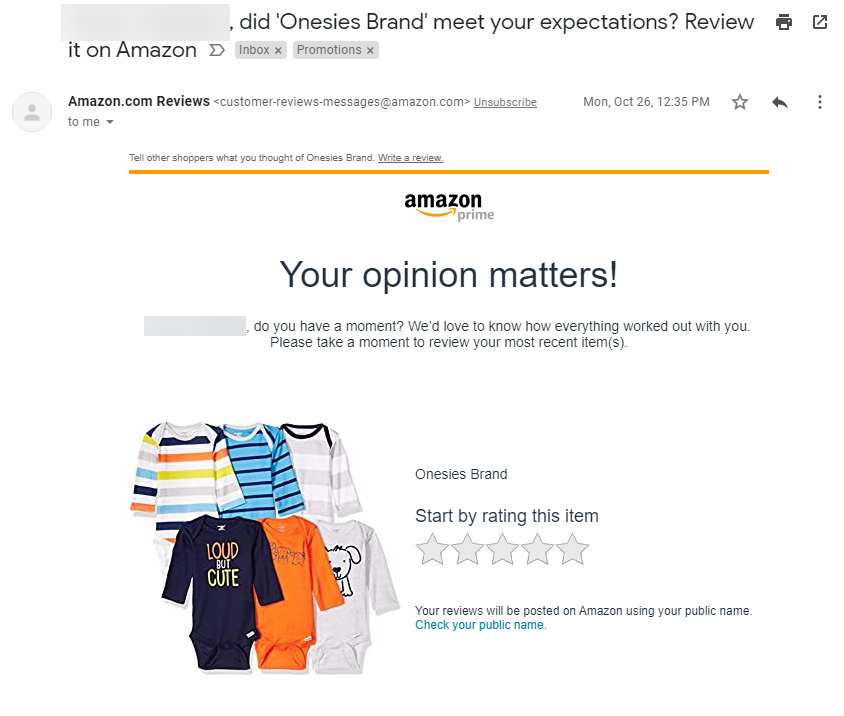 Screenshot by author, March 2023
Screenshot by author, March 2023Using the Request a Review button can be done with the following steps.
To send your customer a request for a seller and product rating, go to Seller Central > Orders > Manage Orders.

If you are primarily FBA, make sure it says “View Seller Fulfilled Orders.” If it says View FBA orders, click that link.
This allows you to toggle between the fulfillment methods.
Then, find the order you want to request a review for and click on where the order number is displayed.
 Screenshot from Amazon, March 2023
Screenshot from Amazon, March 2023Then click the Request a Review button.
 Screenshot from Amazon, March 2023
Screenshot from Amazon, March 2023Several tools on the market now allow to automate this process. It is always important to ensure that the third-party software you use follows Amazon’s terms of service.
Reviews are still vital on Amazon to help you increase conversion rates and lower advertising costs. However, they are no longer the quick-and-easy **** to get the top of the organic results they once were.
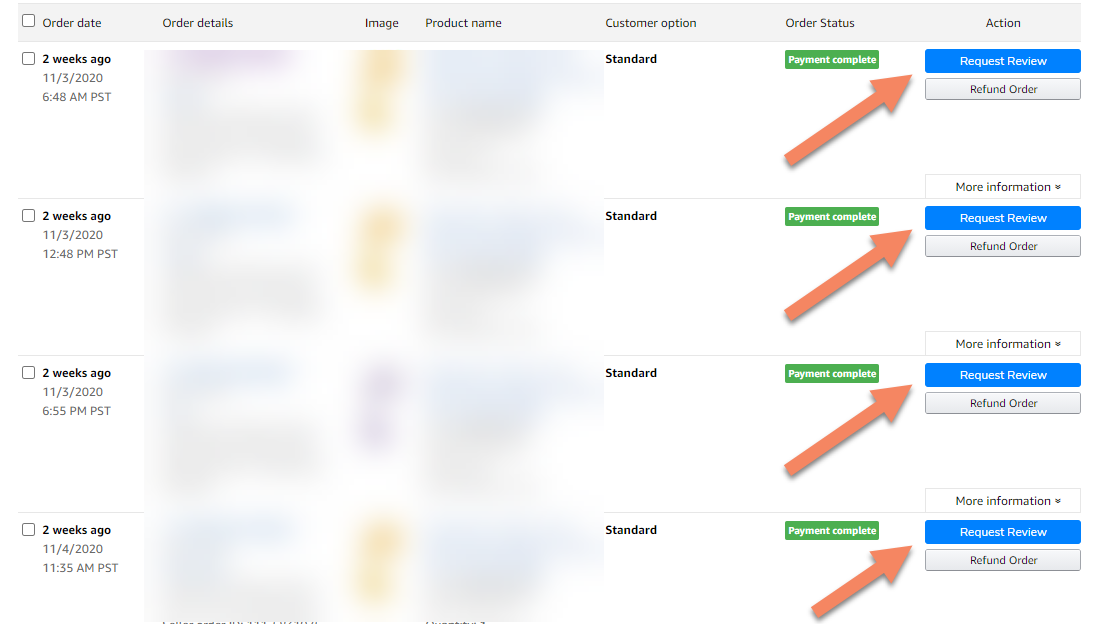 Screenshot from Amazon, March 2023
Screenshot from Amazon, March 2023As more sellers use this tool, Amazon sees an increase in the number of product ratings without accompanying text.
Soliciting Reviews
Here is what Amazon says about soliciting reviews:
“Solicitations:
If you ask others to post content about your products, keep it neutral. For example, don’t try to influence them into leaving a positive rating or review.
Don’t offer, request, or accept compensation for creating, editing, or posting content. Compensations include free and discounted products, refunds, and reimbursements.
Don’t try to manipulate the Amazon Verified Purchase badge by offering reviewers special pricing or reimbursements.
Have a financial or close personal connection to a brand, seller, author, or artist?
- It’s OK to post content other than reviews and questions and answers, but you need to clearly disclose your connection. However, brands or businesses can’t participate in the community in ways that divert Amazon customers to non-Amazon websites, applications, services, or channels. This includes ads, special offers, and “calls to action” used to conduct marketing or sales transactions. If you post content about your own products or services through a brand, seller, author, or artist account, additional labeling isn’t necessary.
- Authors and publishers can continue to give readers free or discounted copies of their books if they don’t require a review in exchange or try to influence the review.”
It is important to actively reach out to customers to get reviews, but also know that it is better to wait for the reviews to accrue over time rather than trying to cheat the system and have your other reviews removed or, worse, potentially have an account suspension.
This also helps to ensure that customers can feel confident in the authenticity of reviews on Amazon.
While many review services on the market promise to cheat the system to get more reviews, remember that Amazon is aggressively pursuing these companies by closing loopholes and even by using litigation to stop these tactics.
If Amazon catches you using black hat tricks for reviews, it can be very difficult to be reinstated, and you could lose access to the platform as a whole.
Conclusion
For our clients, we find that we can gather enough reviews to obtain customer confidence with the available programs. This includes utilizing Voice of the Customer to avoid negative reviews and strategically organizing variation listings on Amazon to have healthy conversion rates.
As the marketplace grows, Amazon is closing the quick and easy ways to rank; sellers need to learn to develop more strategic launches with products that customers genuinely ****.
This has also allowed Amazon to rebuild some of the trust customers have in the reviews on the platform.
Because Amazon is a dynamic and ever-changing ecosystem, it’s essential to regularly check for updates and changes to the terms of service and marketplace guidelines.
Everything in this article is based on the specific state of Amazon Policies at the time it was written.
However, policies can change quickly, so double-check the policies to ensure that what is being recommended here is still the current policy.
More Resources:
Featured Image: Black Salmon/Shutterstock



